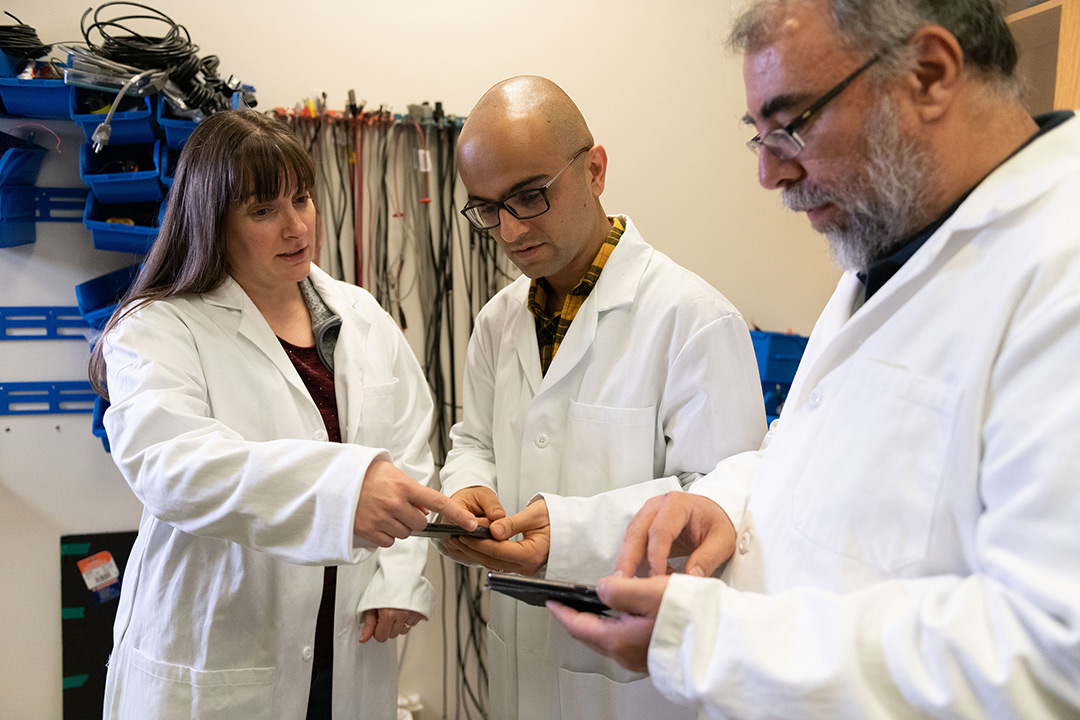Scientists develop way to perform supercomputer simulations of the heart on cellphones
RIT associate professor Elizabeth Cherry helped develop the cardiac dynamics modeling method
Allison Carter, Georgia Tech
A team of scientists from Rochester Institute of Technology and Georgia Tech developed a new approach to perform supercomputer simulations of the heart’s electrophysiology in real time on cellphones.
You can now perform supercomputer simulations of the heart’s electrophysiology in real time on desktop computers and even cellphones. A team of scientists from Rochester Institute of Technology and Georgia Tech developed a new approach that can not only help diagnose heart conditions and test new treatments, but pushes the boundaries of cardiac science by opening up a floodgate of new cardiac research and education.
Heart disease is the leading cause of death worldwide, and cardiac dynamics modeling can be useful in the study and treatment of heart problems like arrhythmias. However, due to the complex electrophysiology of heart cells and tissue, modeling conditions like arrhythmias requires solving billions of differential equations and previously has been limited to only those with access to supercomputers.
 Allison Carter, Georgia Tech Elizabeth Cherry, Abouzar Kaboudian and Flavio Fenton, left to right.
Allison Carter, Georgia Tech Elizabeth Cherry, Abouzar Kaboudian and Flavio Fenton, left to right.“This opens up a lot of new research opportunities, including for RIT undergraduates,” said Elizabeth Cherry, associate professor and director of RIT’s mathematical modeling program and co-author of a new Science Advances article that introduces the new methodology. “I felt really restricted in what I could ask undergraduates to do in Research Experiences for Undergraduates programs or even our full-time students because the previous supercomputer simulations took so long. But now they can work with these complex models in real-time so it opens up a whole new world of opportunities to what they can study.”
In hospital settings, the real-time models could allow doctors to have better discussions with their patients about life-threatening heart conditions.
“This visualization can be very useful for doctors to address a variety of cardiac problems,” said Abouzar Kaboudian, a research scientist at Georgia Tech and co-author. “For example, a doctor can see what would happen if a pacemaker was placed on a particular location of the heart. Or, if the structure from CT scan data was available to a doctor, they could import the structural data for a particular patient and see what would cause an arrhythmia and what would be the course of action to eliminate the arrhythmia.”
The novel approach relies on using WebGL code to repurpose graphics cards to perform calculations that speed up the scientific computing applications. The researchers developed a library that allows for high-performance computing of complex problems that require large-scale simulations to run them. Their streamlined methodology allows users to solve problems as fast as a supercomputer in web browsers that they are already familiar with.
“This opens the door to the possibility of doing patient-specific modeling in a reasonable way,” said co-author Flavio Fenton, professor of physics at Georgia Tech. “There are many problems related to trying to solve these complex models for clinical use, but one of the big bottlenecks was performing these high-performance computing real-time simulations of complex models of the heart. Now they can be done.”
The study was published in Science Advances. For more information, go to http://advances.sciencemag.org/.
This research was supported by the National Science Foundation’s Computer and Network Systems under grants CNS-1446675 and CNS-1446312 and by the National Institute of Health’s National Heart Lung and Blood Institute under grant 1R01HL143450-01. Any opinions, findings, and conclusions or recommendations expressed in this material are those of the authors and do not necessarily reflect the views of the sponsoring agencies.













